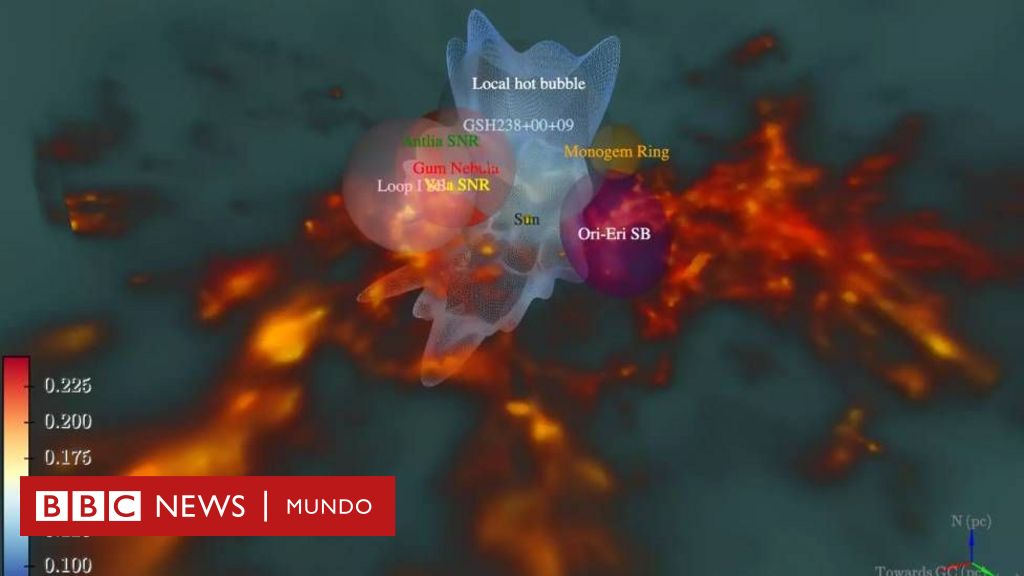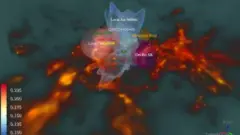An amazing interstellar tunnel discovered by scientists that begins around the solar system and heads towards the constellation Centaurus.


Image Source, © Michael Jung/MPE
- Author, Alejandra Martins
- Author’s title, BBC News World
We live in a hot bubble.
Our Solar System is located in a region of space called the Local Hot Bubble. Local hot bubble or LHB for its English abbreviation.
A telescope of incomparable power made it possible to map this bubble and create a three-dimensional map.
And by studying this map, scientists in Germany discovered not only large fluctuations in temperature, but also something completely unexpected: an interstellar tunnel.
The term “local hot bubble” “refers to the location where the solar system is (hence ‘local’),” Michael Jung, a doctoral student at the Max Planck Institute for Extraterrestrial Physics, or MPE, in southern Germany, explained to BBC Mundo. and lead author of the study.
“This region of space is characterized by very low-density hot gas, with a temperature of one million degrees Kelvin and a density of less than 0.01 particles per cm3.”
The bubble emits X-rays and extends about a thousand light years around the solar system.
Jung and his colleagues used data eROSITA observatory, a powerful X-ray telescopewhich made it possible to create a three-dimensional map of the Local Hot Bubble.

Image Source, Courtesy of Michael Jung
Tunnel opening
What surprised scientists most was the discovery interstellar tunnel towards the constellation Centaurus.
“What we didn’t know was the existence of an interstellar tunnel to Centauri that digs a hole in the cooler interstellar medium (ISM),” said Michael Freiberg, a scientist at the Max Planck Institute for Extraterrestrial Physics and another of the authors. research.
Michael Jung explained to BBC World that the interstellar tunnel is “just connection of two supernova remnants or superbubbles filled with hot gas“
“It’s definitely not a wormhole as the name suggests.”
A wormhole is a theoretical tunnel or shortcut between two points in space-time. (According to Albert Einstein’s general theory of relativity, gravity is the curvature of space-time caused by mass.)

Image Source, © Michael Jung/MPE
Which two places are connected by an interstellar tunnel that scientists call the “Centauri Tunnel”?
“In the specific case of the Centauri Tunnel, one end is definitely the LHB,” Jung said.
“The other may be a nearby superbubble called the Loop I superbubble.”
The study’s authors believe that the Centauri tunnel may simply be a local example of a broader network of hot interstellar medium, supported by bursts of energy released by stars.
Temperature difference
In addition to the tunnel, researchers from the Max Planck Institute discovered another pronounced temperature gradient.
“It is currently believed that this is due to the last supernova explosion that expanded the LHB,” Jung said.
“Shocks created by supernova explosions may superheat the LHB gas asymmetrically, in our view, either due to the location of the explosion sites and/or due to asymmetrical propagation of the impacts due to changes in density and/or due to the reflection of these impacts upon impact against the wall of the LHB.”
The scenarios that created this asymmetry have not been proven, the scientist added.
“Despite this, There is strong evidence that supernova explosions have occurred within the LHB over the last few million years.. “An example is the presence of iron-60 in deep sea crust, an isotope that could only be created in supernovae.”

Image Source, Courtesy of M. Jung
Why is the eROSITA telescope so important?
German X-ray space telescope eROSITA (enhanced X-ray viewing with an array of imaging telescopes), from the Max Planck Institute for Extraterrestrial Physics, was launched in 2019.
The telescope, which is installed on the Russian-German space observatory Spektr-RG (SRG), allows you to observe the entire sky in X-rays every 6 months.
“It is very important that eROSITA was designed to study the entire sky so that we can get information about the LHB bubble observed in all directions while we are inside it,” Jung told BBC Mundo.

Image Source, MPE
The telescope is also unique in that it is located approximately 1.5 million km from Earth. beyond the geocorona of our planet.
“This is very important because Earth’s geocorona (or exosphere, the outermost part of Earth’s atmosphere) is bright in soft X-rays due to an interaction called solar wind charge exchange.”
“Soft X-ray photons with a spectrum very similar to that of the LHB are emitted when neutral Earth particles interact with heavy solar wind ions in the geocorona.”
“To study LHB, it is a bright impurity that varies greatly over time and needs to be separated. Only with the help of eROSITA can we say with certainty that the spectra are free from this source of contamination.“
One of the goals of the eROSITA mission is to obtain the most accurate X-ray map of the sky by 2026.

Image Source, © MPE/IKI
“There are many superbubbles in the vicinity of the Sun”
One of the future studies that Young is most interested in is the state of the plasma in the Local Hot Bubble.
Plasma is a state of matter similar to gaseous, but with the peculiarity that some of its particles have an electrical charge.
These studies may reveal traces of a supernova explosion “that happened not so long ago.”
On the other hand, “with new X-ray observatories on the horizon (e.g.
“Meanwhile, we have no shortage of hot bubbles to explore other than the local one.”
“There are many superbubbles in the solar vicinity and beyond, such as the eROSITA bubbles, the largest X-ray structure in the sky, the origin of which remains unknown.”

Subscribe here Sign up for our new newsletter to receive a roundup of our best stories of the week every Friday.
And remember that you can receive notifications in our application. Download the latest version and activate them.
